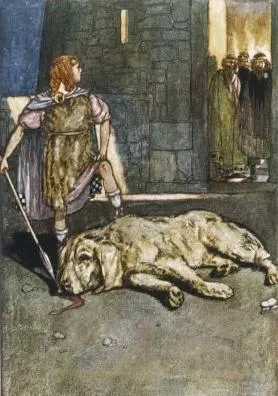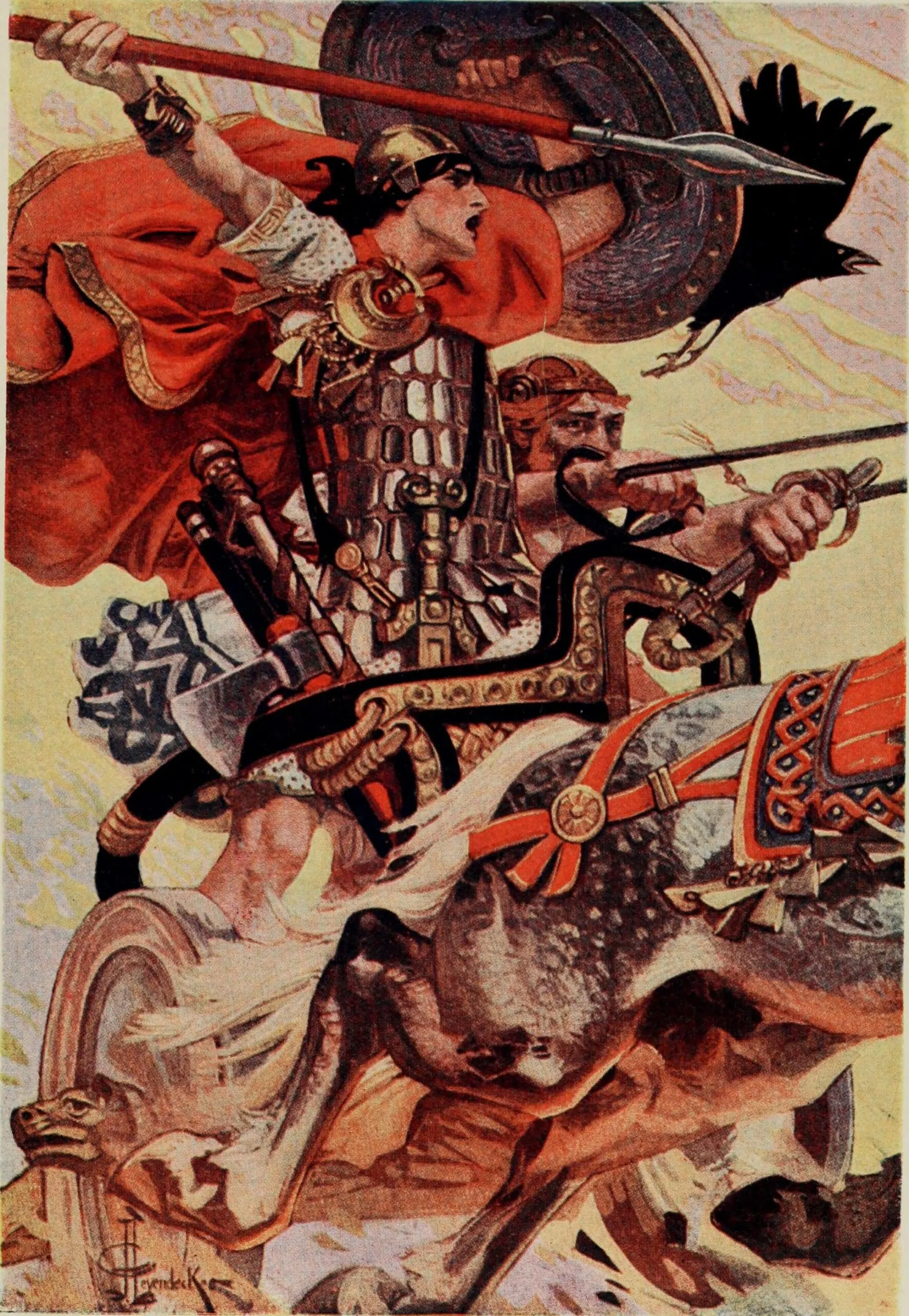Irish mythology is not something I have covered much on Irish Around The World. But I thought there was no better time to start than today. And what better way to start than with the legendary Cu Chulainn?
Journey back in time, over a thousand years before the Norman invasion of Ireland, to an era where myth and history intertwine, creating a rich tapestry of legend and lore. In this mystical world of ancient Ireland, a legendary figure stands tall – Cú Chulainn, the Hound of Ulster.
A hero of the Ulster Cycle, one of the four great cycles of Irish mythology, Cú Chulainn’s story is a cornerstone of Celtic folklore, echoing the values, beliefs, and spirit of the Irish people.
And if you want to learn, you can read one of these top ten books on Cú Chulainn.
TL;DR: Quick summary of this article
If you like me and don’t like to read large paragraphs of text, I thought it would be nice to summarize this post into bullet points. You can read further details below, but these are the key points.
Key Points About Cú Chulainn: The Legendary Hound of Ulster 💪

“Setanta Slays the Hound of Culain”, illustration by Stephen Reid from Eleanor Hull, The Boys’ Cuchulain, 1904
- Historical Context:
- Cú Chulainn’s legend dates back to the pre-Christian era, over a thousand years before the Norman invasion of Ireland.
- Identity of Cú Chulainn:
- A central figure in Irish mythology, particularly the Ulster Cycle
- Known originally as Sétanta, he earned the name Cú Chulainn after killing Culann’s guard dog and vowing to take its place.
- Son of the god Lugh and Deichtine, sister of King Conchobar mac Nessa.
- Key Characteristics:
- Renowned for superhuman strength, exceptional combat skills, and heroism.
- Symbolizes bravery, loyalty, and the archetype of the tragic hero.
- Famous Tale – Táin Bó Cúailnge (The Cattle Raid of Cooley):
- He is most celebrated for his heroic defence of Ulster in the Táin Bó Cúailnge against Queen Medb’s forces.
- Demonstrates his unparalleled warrior skills and battle frenzy, known as ‘ríastrad’.
- Tragic Destiny:
- His life, marked by prophecy, was destined to be heroic yet short-lived.
- His death, fulfilling the tragic prophecy, adds depth to his legend.
- Cultural Impact:
- Cú Chulainn’s story is more than a myth; it’s an integral part of Irish heritage, reflecting the values and spirit of ancient Ireland.
- It continues to inspire and captivate, symbolizing the heart of Celtic folklore.
Who was Cú Chulainn?

Cú Chulainn, originally named Sétanta, was a mythical warrior known for his superhuman strength, skill in combat, and unwavering heroism. Born to the god Lugh and Deichtine, sister of King Conchobar mac Nessa of Ulster, he was destined for greatness from birth.
Cú Chulainn earned his renowned name after slaying the fearsome guard dog of Culann, a blacksmith, and taking its place until a new guard could be trained. His exploits, most notably in the epic saga “Táin Bó Cúailnge” (The Cattle Raid of Cooley), have cemented his status as a symbol of bravery, loyalty, and the tragic hero in Irish culture.
The Birth of a Legend: Sétanta to Cú Chulainn
Our tale begins with a young boy named Sétanta, who is destined for greatness. The nephew of King Conchobar mac Nessa, Sétanta’s journey to becoming Cú Chulainn is as fascinating as his heroic feats. The transformation from Sétanta to Cú Chulainn, which means ‘the hound of Culann’, occurred following a pivotal event. The young Sétanta, displaying remarkable strength and bravery, slew the ferocious guard dog of the smith Culann. In reparation, he vowed to protect Culann’s estate until a new guard dog could be raised, thus earning the name Cú Chulainn.
The Táin Bó Cúailnge and the Defense of Ulster
The most famed tale of Cú Chulainn is undoubtedly his role in the Táin Bó Cúailnge or the Cattle Raid of Cooley. During this epic conflict, Cú Chulainn single-handedly defends the province of Ulster against the armies of Connacht, led by the formidable Queen Medb.
This tale is replete with battles against fearsome warriors, encounters with mystical creatures, and displays of his otherworldly warrior skills.
Cú Chulainn’s Tragic Destiny
While the tales of Cú Chulainn’s heroics are many, his story is also tinged with tragedy. Foretold prophecies hinted at a heroic but short life. His demise, as foretold, was a poignant end to a life lived in the fierce glow of heroism and battle.
This tragic element adds depth to his character, painting him not just as a warrior but also as a figure of complex emotions and destiny.
Cú Chulainn’s Legacy in Irish Culture
Cú Chulainn’s impact on Irish culture cannot be overstated. He is not just a mythical figure; he represents the ideals of courage, loyalty, and the complex nature of heroism.
Cú Chulainn, an iconic figure in Celtic folklore, has significantly influenced popular culture across various mediums. His legendary status is acknowledged in contemporary music, notably in the title theme of the film ‘The Boondock Saints,’ as well as in songs by renowned bands such as Thin Lizzy’s ‘Róisín Dubh’ and The Pogues’ ‘The Sickbed of Cú Chulainn.’
In the realm of comics, Cú Chulainn has been portrayed in series like Marvel Comics, where he is depicted within the Celtic pantheon, and in 2000AD. His influence extends to television and anime, with notable appearances in shows such as ‘Gargoyles’ and the ‘Fate’ series.
The character’s versatility and appeal are further evidenced in the world of video games. Cú Chulainn has been featured in various roles: as an esper in ‘Final Fantasy XII,’ a demon in ‘Final Fantasy Tactics’ and the ‘Megami Tensei’ series, and as a playable character in ‘SMITE.’ These diverse representations in popular culture underscore Cú Chulainn’s enduring legacy and the continued relevance of Celtic mythology in modern entertainment.
His story has been passed down through generations, capturing the imagination of all who hear it.
Gaelic Terms and Their Meanings
To truly appreciate the story of Cú Chulainn, understanding some Gaelic terms is essential. Here are a few:
- Táin Bó Cúailnge (Tawn bo Cool-nya): The Cattle Raid of Cooley.
- Ríastrad (Ree-ah-strad): The warp-spasm or battle frenzy that Cú Chulainn undergoes in battle.
- Gae Bolga (Gay Bol-gah): Cú Chulainn’s legendary spear, known for its deadly accuracy and lethal power.
Conclusion: The Enduring Legacy of Cú Chulainn
The legend of Cú Chulainn is more than just a story; it’s a vivid tapestry of heroism, sacrifice, and destiny. It’s a narrative that binds the ancient to the modern, bridging centuries with timeless themes. In Cú Chulainn, we find not just a mythical hero but a symbol of the enduring strength and spirit of Ireland.
His story invites us to explore the rich and mystical world of Irish mythology, reminding us of the power of tales to inspire and teach. The adventures and trials of Cú Chulainn offer more than entertainment; they are reflections of life’s complexities, challenges, and the eternal quest for meaning and honour.
Now if you have been reading so far and want to take a deep dive or just want to learn a bit more. Then I suggest you read one of these top 10 books about Cú Chulainn
As the Irish proverb goes, “Ní againn ciall roimh aois” (Wisdom doesn’t come before age), but the story of Cú Chulainn teaches us that heroism and valour know no age. His journey from a youthful warrior to a figure of legendary stature speaks to the universal path of growth and understanding. It teaches us that courage and strength are not bound by time or age and that true heroism lies in the heart.
Moreover, Cú Chulainn’s story is a testament to the rich cultural heritage of Ireland. It’s a narrative that has been shared through generations, a thread in the fabric of Irish identity. In art, literature, and popular culture, the echoes of his deeds continue to resonate, a reminder of a past that still lives within the present.
In the annals of Irish lore, Cú Chulainn remains an eternal figure, his story echoing through the ages, as captivating and powerful as ever. It’s a legacy that continues to inspire, to teach, and to hold a mirror to the human experience. In the legend of Cú Chulainn, we find a piece of ourselves and a connection to the ancient soul of Ireland.
Thanks for reading,
Stephen
